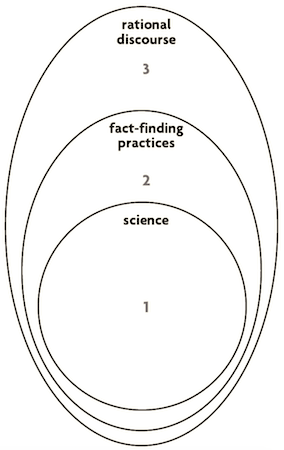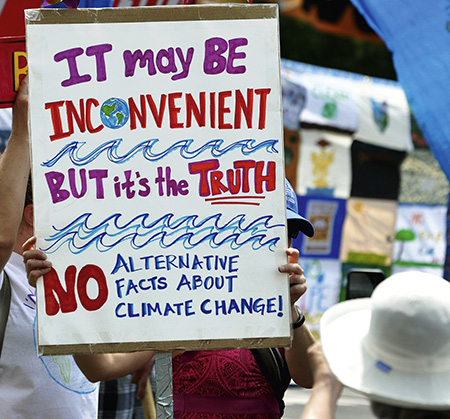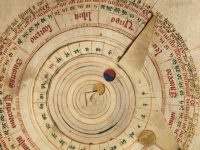How connected are the major forms of irrationality?
An analysis of pseudoscience, science denial, fact resistance and alternative facts

Science is a fact-finding practice, but there are many other fact-finding practices that apply largely the same patterns of reasoning in order to achieve as reliable information as possible in empirical issues. The fact-finding practices form in their turn a subcategory of rational discourse, a wider category that also encompasses argumentation on non-empirical issues. Based on these categories, it is easy to see the relationship between on the one hand pseudoscience, and on the other hand fact resistance, disinformation, and fallacies of reasoning. The flaws in argumentation are similar, and the main difference is whether or not the subject matter falls within or without the realm of science.
Keywords: pseudoscience, science denial, fact resistance, alternative facts, disinformation.
In the last few years, it has become more and more obvious that the dissemination of unreliable information is an important social problem. However, the focus has not been on the «classical» forms of pseudoscience – astrology, ufology, etc. Instead, the discussion has been couched in other terms, such as science denial, fact resistance, and alternative facts. Are these just subspecies of pseudoscience, or are they in some way fundamentally different?
A key issue
Alice: Can you help me? I can’t find my keys.
Bailey (her partner): Have you checked your pockets carefully?
Alice: Yes. I have emptied all of them.
Bailey: Perhaps you left the keys in the bathroom?
Alice: No, I have looked carefully, and they are not there.
Bailey: What about your coat pockets?
Alice: I have checked, but I can do so again. (Searches the coat pockets carefully.) No, they are not there.
Bailey: Are you sure the keys are in the house?
Alice: Yes. No one was at home when I came. So I must have opened the door myself, and I didn’t leave the house after that, so the keys must be here in the house.
Bailey: Perhaps you brought something with you that you put down somewhere, and then you put the keys in the same place.
Alice: I only had a newspaper with me.
Bailey: And where did you put it?
Alice: On the kitchen table. It’s still there.
Bailey (after searching the kitchen table): But the keys aren’t there.
Alice: That was almost my last hope.
Bailey: Don’t give up that easily! They must be somewhere. Let’s have a look at the shelf in the bedroom where you charge your cell phone.
Alice: That’s no idea. I still have the phone in my pocket.
Bailey: Don’t be too sure. Perhaps you went there to charge it, and then changed your mind. Let me check… (Leaves and comes back after a minute.) No, its not there.
Alice: How bad. I really don’t know where to look now.
(The doorbell rings. Alice opens.)
The visitor: Hi, my name is Frances. I’m your new neighbour.
Alice: Nice to meet you. My name is Alice, and this is Bailey. Please come in!
Frances: Thanks, but I don’t have much time. I hadn’t planned to visit you today, but I saw these keys in your front door, clearly visible from the street. So I thought I should tell you.
Alice: Thanks a lot, that’s awfully kind of you. I have been searching for those keys for the last half hour or so. Sure you don’t want a cup of coffee?
Frances: I’d love to, but I’m quite in a hurry. Let’s meet again soon. Good-bye.
Alice and Bailey: Good-bye.
Bailey: What a relief. I could have gone on searching the house for hours without thinking of the front door.
Alice (putting the key in its usual place in a cupboard): Yes, and I was thoroughly wrong when I said that since I entered the house with the keys, they must be inside the house.

Efforts to find empirical evidence are present in all human societies, including indigenous ones. A fascinating case is that of the groups of hunters from the Kalahari desert who practice what is known as «persistence hunting»: they follow an animal’s footsteps for hours, even days, until the prey is exhausted. In the process, participants discuss, propose and discard hypotheses and seek empirical evidence to find the animal. In the image, a group of hunters from Namibia look at the ground to find the trail of the animal they are following. / Claude B. / Flickr
The participants in this dialogue do a lot of the things that scientists also do. They engage in activities such as: proposing hypotheses (Bailey proposed several places where the keys might be), testing hypotheses (they both searched places where they hypothesized that the keys could be), drawing conclusions (Alice concluded that since she had opened the house with the keys, they had to be in the house), criticizing conclusions (Bailey criticized Alice’s conclusion that since her phone was in her pocket, the keys could not be where she charges her phone), accepting pertinent information from outsiders (they both accepted Frances’s information that the keys were in the front door), and admitting one’s own mistakes (Alice admitted that she was wrong in concluding that the keys had to be in the house).
All of these are behaviours that we consider typical for science. But surely, searching for a key is not a scientific activity?
Fact-finding practices
Searching for a key is certainly not a scientific activity, but just like the empirical sciences it is an activity aimed at finding out empirical facts; in short: a fact-finding activity. Besides science, there are several other well-established fact-finding activities in our societies. Mechanics searching for the defect in a malfunctioning machine, doctors seeking the right diagnosis for a patient, journalists evaluating what their sources have told them, police officers performing a criminal investigation, and a jury trying to determine if the defendant has committed the crime – all these are cases of co-operation to find out the facts about something.
Such fact-finding practices can be found in all human societies, including indigenous ones. Anthropologists have usually not paid much attention to them, but one fascinating case has been investigated in some detail: the tracking of animals in traditional hunting societies (Liebenberg, 1990, 2013).
«Are science denial,
fact resistance, and alternative facts just subspecies of pseudoscience?»
Hunters using traditional weapons usually cannot kill large prey immediately. Therefore, they have to track and follow the animal for many hours before they can kill it. This is called «persistence hunting». Although most game animals are faster than humans over short distances, humans have more endurance, and they can therefore run down prey by pursuing them for many hours, often a day or two. This technique has been used by hunter-gatherers all around the world (Carrier et al., 1984). Hunters in the Kalahari desert (which covers large parts of Botswana and Namibia) are masters of this type of hunting. It is performed by small groups of men. Tracking the fleeing animal is «a process of creative problem solving in which hypotheses are continually tested against spoor evidence, rejecting those which do not stand up and replacing them with better hypotheses» (Liebenberg, 1990, p. 71). The group of hunters who follow an animal search for its tracks and analyse them. They discuss vividly, proposing hypotheses on where the animal may have gone, criticizing and testing each other’s hypotheses. When discussing animal behaviour, they take great care to cite the evidence in favour of various claims and to distinguish between facts (for instance, tracks that they have seen) and hypotheses. They are willing to admit gaps in their own knowledge, and they are often sceptical against each other’s statements (Blurton-Jones & Konner, 1976). All of this corresponds closely to the unwritten rules of scientific discussions that today’s young scientists have to learn.
All the fact-finding practices aim at finding out how things are, in contradistinction for instance to how we wish them to be, or how they should or could be. Largely due to this common purpose they have many characteristics in common. The following five are particularly important.
«All the fact-finding practices aim at finding out how things are, in contradistinction for instance to how we wish them to be»
First, fact-finding practices are all objectivist, in the sense that they rely on the assumptions that we all live in the same world and that the facts about it should be the same for all of us. For instance, when a group of Kalahari hunters discuss where the antelope might have gone, they are by no means epistemic relativists. Their discussion is based on the assumption that there must be one single truth in this matter. The antelope could not be «far to the east in your world but still close to us in my world». They are looking for shared, well-founded judgments about the world in which we all live.
Secondly, fact-finding practices make a clear distinction between facts and values, and aim at finding the former. It is a basic feature of human reasoning that we are capable of distinguishing our factual beliefs from our other attitudes and reactions to what happens around us. We do this all the time in our daily lives – more or less perfectly – but in fact-finding practices we have to do it more carefully. This is the reason why juries are often instructed that they have «a duty to find the facts» and «must not be influenced by any personal likes or dislikes, prejudices or sympathy» (Hornby, 2014, p. 60). It is also the reason why scientists are trained to let themselves be influenced as little as possible by this type of values (other types of values can improve the fact-finding process; this applies for instance to positive evaluations of various scientific virtues; see Hansson, 2017a).

Figure 1. The areas of rational discourse. Area 1 represents scientific subject matters; area 2, empirical subject matters that do not belong to the realm of science; and area 3, non-empirical subject matters that are accessible through rational discussion. / Sven Ove Hansson
Thirdly, although fact-finding practices make use of both reasoning and empirical investigations, they always give precedence to well-conducted empirical observations. On a hunt, our knowledge about animal behaviour may give us strong reasons to believe that the steenbok will head for the waterhole, but if its tracks go in the opposite direction, then we will have to change our minds. Jones’s motives and previous crime record may give the police strong reasons to believe that he committed the crime, but if the evidence from the crime scene shows that someone else did it, then they will have to redirect their investigations.
Fourthly, fact-finding practices are communal undertakings in which contributions are both welcomed and critically appraised, independently of whom they come from. On the one hand, this means that proposals and observations by the youngest and most inexperienced participant in a Kalahari hunting party, the police cadet taking part in her first criminal investigation, and the trainee mechanic helping to identify what is wrong with a motor, are all encouraged to contribute to the discussion, and their contributions will not be dismissed because of their inexperience. On the other hand, it also means that although a highly-experienced participant in any of these practices will have everyone’s ear, what she says can always be refuted by evidence or convincing arguments presented by anyone else who takes part in the endeavour.
Juries have been described as representing a «democratic culture in which rich and poor citizens from all walks of life came together as equals» (Amar, 2002, p. 108. Cf. Wilkenfeld, 2004, pp. 2320–2322). Jurors are typically instructed that «you ought to pay proper respect to each other’s opinions and you ought to listen with a mind open to being convinced by each other’s arguments» (Hornby, 2014, p. 276). The same instruction would be equally appropriate for a group of hunters tracking down a prey, or for a group of scientists attending a seminar or workshop.
Fifthly, fact-finding practices are open in the sense of aiming at continuous improvement. Substantial criticism has to be taken seriously. New knowledge must be acknowledged and assimilated, and cherished beliefs have to be given up when the evidence gives reason to do so. Communal fact-finding is incompatible with rigid belief systems based on allegedly incorrigible beliefs.

Science
Some of the fact-finding practices are called «sciences». The sciences differ from other such practices in being more systematized and specialized, and focusing more on generalizations and explanations. This is a matter of degree rather than kind. The Kalahari hunters have use for knowledge about general patterns in animal behaviour, but the emphasis on such generalities is much weaker than in biological science. Obviously, there are also large differences in terms of scale and resources between modern science and indigenous fact-finding practices, but it is nevertheless important to recognize what they have in common. The fact-finding practices in traditional societies are forerunners of modern science, just as oral storytelling is the origin of modern literature and filmmaking. There are strong continuities between the thought patterns in modern science and those that we all employ, like our ancient ancestors, in various everyday situations when we need to find out what is really the case.
Science is a universal project, striving for knowledge that is common to all of humanity. The different sciences are interdependent, and form together a community of knowledge disciplines. They all strive to obtain reliable general knowledge, and they all respect each other in their respective areas of specialization (Hansson, 2007). Obviously, nothing like modern science was possible before the era of global communications. It is often called «Western science», but this is a misnomer that downplays its universal nature and its multicultural origins. As we have seen, science is based on a way of thinking that can be found in fact-finding practices in all human cultures. It relies on crucial discoveries by ancient Iraqi (Mesopotamian) astronomers, Indian mathematicians, and Arabic physicists (Teresi, 2002). Today, scientists on all continents make essential contributions at the research front. Calling science «Western» is Eurocentric hubris.
This is not just a matter of setting history right. The idea that science is a unique practice, developed among a Western elite, and radically different from any other practice in human history, is a dangerous myth. It is dangerous because it contributes to estranging the public from science. In today’s world, we need to emphasize what is common to all of humanity and what connects different cultures with each other. This applies not least to our fact-finding practices.
Rational discourse
Fact-finding practices form part of a larger category, namely rational discourses (see Figure 1). There are also rational discourses that are not devoted to (empirical) fact-finding. Non-empirical sciences, such as mathematics and philosophy, are prominent examples, and so is legal deliberation on how the law should be interpreted or developed. A rational discourse that does not refer to empirical reality differs from fact-finding practices in having conceptual and logical coherence as its ultimate criterion, rather than agreement with empirical observations. In spite of this, the thought patterns are similar in many respects. For instance, hypotheses are advanced and tested, but these tests are usually called something else (such as «thought experiments» or «examples»), and they concern coherence and intuitive plausibility, rather than empirical validity.
All forms of specialized, rational discourse – whether fact-finding or not – can be seen as enhancements of patterns that are also found in other, less specialized deliberations and conversations. Even in simple everyday conversations we expect a certain level of rationality. In some contexts, it is particularly important to get things right and to make sure that we understand each other. We then have to express ourselves as clearly and precisely as possible, take the arguments of others seriously, and accept a convincing argument no matter who puts it forward. These are universal virtues of rational deliberation and discussion, independently of the context and the subject matter, but in some contexts and for some subject matters they are particularly important.
In popular culture, a high degree of rationality is often associated with a lack of empathy and general emotional deficiency. Obviously, certain types of emotions stand in the way of rationality. Rational argumentation has to be impersonal in the sense of focusing on standpoints and ideas, abstracted from their bearers. However, there are other types of emotions that are essential for rationality. In any kind of rational reasoning, we must be emotionally prepared to go where the argument leads and to give up cherished ideas. A participant in a rational conversation must be able to engage seriously in other participants’ intellectual endeavours. She must be prepared to give them right even when they point out weaknesses in her own arguments and ideas. This can be emotionally taxing. The capacity to be rational is therefore to a large extent an emotional capacity.

Scientific denialism often acts by creating false polemics. One of the current cases of this phenomenon is climate change denialism. In the images, demonstrators of the Peoples Climate March, held on April 2017 in Washington (USA). / Photo: Edward Kimmel / Flickr
Variants of delusion
Let us now return to the question which we started with: the connections among the commonly discussed forms of irrationality, such as pseudoscience, science denial, fact resistance, disinformation («alternative facts»), and logical fallacies.
Pseudoscience means, literally, “false science”; in other words, delusive claims or activities within the area marked 1 in Figure 1. As I have argued more extensively elsewhere (Hansson, 2013), a pseudoscience can be defined as a doctrine satisfying the three criteria that a) its subject area is within the domains of science, b) it is so unreliable that it cannot at all be trusted, and c) its major proponents present it as the most reliable information that is available. Pseudoscience comes in two major forms (Hansson, 2017b). One of these is pseudo-theory promotion. Pseudosciences within that category have as their primary aim to promote a particular theory that deviates from science. Major examples are homeopathy, phrenology, reflexology, astrology, scientology, ufology, and ancient astronaut theories.
The other form of pseudoscience is science denial(ism). These are the pseudosciences that are primarily driven by a desire to fight down some scientific theory or branch of science. The term was first used about holocaust denialism, the pseudoscientific doctrine that the Nazi holocaust did not take place. Today the most prominent form is climate science denialism. Other examples are creationism (whose main goal is to overthrow evolutionary biology), relativity theory denial, tobacco disease denial, HIV denialism, and vaccination denialism.
There is no sharp line between pseudo-theory promotion and science denialism. Most forms of pseudoscience have elements of both, but can nevertheless be classified as belonging predominantly to one of them. The two forms of pseudoscience have many characteristics in common, for instance their neglect of refuting information, their cherry-picking of data and unwillingness to consider the whole body of scientific evidence, their inability to get published in peer-reviewed journals, and their proneness to conspiracy theories to account for this and other failures.
However, there are also interesting differences between the two forms of pseudoscience. Perhaps most importantly, science denialism usually proceeds by producing false controversies; i.e., claims that there is a scientific controversy when there is in fact none. This is an old strategy that was applied already in the 1930s by relativity theory deniers (Wazeck, 2009, pp. 268–269). In more recent years it has been used extensively by tobacco disease deniers sponsored by the tobacco industry and by climate science denialists sponsored by the fossil fuel industry (Boykoff, 2008; Boykoff & Boykoff, 2004; Dunlap & Jacques, 2013; Oreskes & Conway, 2010). In contrast, this strategy is seldom used in pseudo-theory promotion. Instead, advocates of teachings such as astrology and homeopathy tend to downplay the conflicts between their own claims and those of mainstream science, and describe their theories as much more easily compatible with conventional science than what they really are.
«Science is a universal project, striving for knowledge that is common to all of humanity»
In area 2 of the diagram we find erroneous claims within the realms of other fact-finding practices than science. Since the basic rules for reasoning and investigation are essentially the same as in science, the flaws in these claims are usually of the same kind as in pseudoscience. For instance, in January 2017 Donald Trump repeatedly claimed that his inauguration ceremony attracted a larger crowd than those of his predecessor, in spite of photographic and other evidence showing indubitably that «his» crowd was in fact much smaller (Ford, 2017). This is an example of the same type of neglect of evidence that we find for instance among creationists, anti-vaccinationists, and flat earth believers. The only reason why we do not call Trump’s claims about crowd size «pseudoscientific» is that they concern issues outside of the realm of science. In general, the fallacies that are typical of pseudoscience are also common in topics that we entrust to fact-finding journalists rather than scientists. For instance, numerous Internet sites are devoted to cherry-picking crimes committed by members of a particular religious or ethnic group in order to create the wrongful impression that the presence of this group threatens everyone else’s security.
We can distinguish, in this area, between fact resistance and disinformation. By fact resistance, we mean an unwillingness to accept what is for good reasons generally accepted as valid knowledge. By disinformation, according to the Oxford English Dictionary, «the dissemination of deliberately false information». There is a close analogy with the distinction between science denial and pseudotheory promotion. In this case as well, the distinction is a matter of degree rather than a strict dichotomy.
Finally, in area 3 of the diagram we find fallacies in discussions on non-empirical subject matter. This includes errors in mathematics and other formalized disciplines as well as non-sequiturs in ethics and other branches of philosophy. The latter are the types of delusions that philosophers are usually best suited to disclose, since the subject matter is within their expertise. But the recent re-emergence of political forces that use pseudoscience and disinformation to reach power makes is necessary for philosophers to pay close attention to the whole spectrum of disinformation and faulty reasoning.
References
Amar, A. R. (2002). Second thoughts. Law and Contemporary Problems, 65, 103–111.
Blurton-Jones, N., & Konner, M. (1976). !Kung knowledge of animal behaviour. In R. B. Lee, & I. DeVore (Eds.), Kalahari hunter-gatherers (pp. 326–348). Cambridge: Harvard University Press.
Boykoff, M. T. (2008). Lost in translation? United States television news coverage of anthropogenic climate change, 1995-2004. Climatic Change, 86, 1–11. doi: 10.1007/s10584-007-9299-3
Boykoff, M. T., & Boykoff, J. M. (2004). Balance as bias: Global warming and the US prestige press. Global Environmental Change, 14(2), 125–136. doi: 10.1016/j.gloenvcha.2003.10.001
Carrier, D. R., Kapoor, A. K., Kimura, T., Nickels, M. K., Satwanti, Scott, E. C., ... Trinkaus, E. (1984). The energetic paradox of human running and hominid evolution. Current Anthropology, 25(4), 483–495. doi: 10.1086/203165
Dunlap, R. E., & Jacques, P. J. (2013). Climate change denial books and conservative think tanks: Exploring the connection. American Behavioral Scientist, 57(6), 699–731. doi: 10.1177/0002764213477096
Ford, M. (2017, 21 January). Trump’s press secretary falsely claims: ‘Largest audience ever to witness an inauguration, period’. The Atlantic. Retrieved from https://www.theatlantic.com/politics/archive/2017/01/inauguration-crowd-size/514058/
Hansson, S. O. (2007). Values in pure and applied science. Foundations of Science, 12(3), 257–268. doi: 10.1007/s10699-007-9107-6
Hansson, S. O. (2013). Defining pseudoscience – and science. In M. Pigliucci, & M. Boudry (Eds.), The philosophy of pseudoscience (pp. 61–77). Chicago: Chicago University Press.
Hansson, S. O. (2017a). How values can influence science without threatening its integrity. In H. Leitgeb, I. Niiniluoto, P. Seppälä, & E. Sober (Eds.), Logic, methodology and philosophy of science – Proceedings of the 15th International Congress (pp. 207–221). London: College Publications.
Hansson, S. O. (2017b). Science denial as a form of pseudoscience. Studies in History and Philosophy of Science, 63, 39–47. doi: 10.1016/j.shpsa.2017.05.002
Hornby, D. B. (2014). Judge D. Brock Hornby’s 2014 Revisions to pattern criminal jury instructions for the district courts of the First Circuit. Retrieved from http://federalevidence.com/pdf/JuryInst/1st.Crim.6.2014.pdf
Liebenberg, L. (1990). The art of tracking. The origin of science. Cape Town: David Philip Publishers.
Liebenberg, L. (2013). The origin of science. The evolutionary roots of scientific reasoning and its implications for citizen science. Cape Town: CyberTracker.
Oreskes, N., & Conway, E. M. (2010). Merchants of doubt: How a handful of scientists obscured the truth on issues from tobacco smoke to global warming. New York: Bloomsbury Press.
Teresi, D. (2002). Lost discoveries: The ancient roots of modern science, from the Babylonians to the Maya. New York: Simon & Schuster.
Wazeck, M. (2009). Einsteins Gegner. Die öffentliche Kontroverse um die Relativitätstheorie in den 1920er Jahren. Frankfurt: Campus Verlag.
Wilkenfeld, J. (2004). Newly compelling: Reexamining judicial construction of juries in the aftermath of Grutter v. Bollinger. Columbia Law Review, 104(8), 2291–2327. doi: 10.2307/4099360





